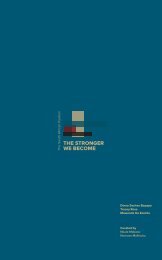TSWB Catalogue
Create successful ePaper yourself
Turn your PDF publications into a flip-book with our unique Google optimized e-Paper software.
Ka Zenzile’s work is therefore not necessarily about ‘visual art’ per say but rather the language of art, where visual<br />
references and language is placed within a particular context. This context, he seems to suggest, is stuck<br />
somewhere between challenging pedagogies and epistemologies and using the very same methodologies to<br />
subvert a way of seeing and thinking. As noted by wa Thiongo, ‘how we see a thing – even with our eyes – is very much<br />
dependent on where we stand in relationship to it’. 31 Ka Zenzile’s oeuvre thus becomes visual anecdotes that draw<br />
attention to how he is not only working with aesthetics, which he poignantly points out are part of how he grew up in<br />
formulating his own genealogy, background and memory. Ka Zenzile is not only creating an identity for himself through<br />
an artistic expression that points to how one does not only view themselves in their environment, but also much like wa<br />
Thiongo describes, through a way of questioning one’s perspective. His practice thus becomes an artistic language that<br />
does not only root itself in creating what wa Thiongo describes as ‘the quest for relevance’ but also intuitively drawing<br />
from imagery that are themselves relevant in the public domain. Relevance is an important currency in linking visual art<br />
to how socio-political conditions govern perspectives and how these are often conflicted by one’s relationship to a sense<br />
of selfhood. Wa Thiongo notes that ‘certainly the quest for relevance and for a correct perspective can only be<br />
understood and be meaningfully resolved within the context of the general struggle against imperialism’, which he<br />
further points out is not always easy to see in literature. 32 What wa Thiongo seems to be highlighting is a consciousness<br />
around pedagogies, those that determine the way in which we access the world and understand our place in it.<br />
correct perspective is even harder to see or suggest in terms of visual art, and especially within a gallery or museum<br />
space where art and viewing art is often presented through a Euro-centric lens. Ka Zenzile’s is certainly aware of a<br />
tension that exist in how his practice oscillates between the language of self-articulation and assertion and a deep<br />
awareness of how the self is pronounced through a relationship to the institutional structures that govern citizenship and<br />
nationhood in present society. As noted by Nkule Mabaso ‘to understand the psychological motivation of this present<br />
society one must unpack, as ka Zenzile does, the historical legacy that the current democratic politic denies, hides, and<br />
at will, forcefully represses’. 33 While his work may be read as confrontational, this is to be understood as intentional and<br />
deliberate precisely because it ‘draws from poignant historical and contemporary political moments occurring in world<br />
history’. 34 The process of engaging with his work is therefore not determined by its placement within a particular space<br />
i.e. a gallery but rather bold relationship to its context. Mabaso further explains how ‘by sweeping across history ka<br />
Zenzile tries to use his materials not just to define himself, but to challenge ideologies, stereotypes associated wit h<br />
being black by appealing to the viewer’s imagination and experience of the social’). 35<br />
Ka Zenzile like many other young artists living and working in an era where political ideology is not only competing with<br />
the affluence and influence of popular culture is in a process of articulating a particular voice of relevance that forms part<br />
of a lineage of artists that have carved out an artistic language uniquely informed by a sense of conscious selfhood.<br />
References<br />
Koloane, David. “The Identity Question: Focus on Black South African Expression,”<br />
Third Text: Critical Perspectives on Contemporary Art and Culture, vol 23 (1993):<br />
99 – 102.<br />
Koloane, David. “Art Criticism for whom?” In Deepwell, K. Art Criticism and Africa,<br />
Saffron Books: London, 1998.<br />
Mabaso, Nkule. “The Art of the Possible: Mawande ka Zenzile,” Artthrob .<br />
Available Online: https://artthrob.co.za/2015/05/16/the-art-of-the-possible/<br />
[Accessed 31 March 2019]. 2015.<br />
Tsotsi, Themba. “Archetypocalypse,” NKA: Journal of Contemporary African Art,<br />
No. 42 – 43 (2018): 298 -300.<br />
O’Toole, Sean. “Maybe if you made this video it would be more technically<br />
resolved!, Artthrob: Contemporary Art in South Africa, published 5/2/2014,<br />
Available Online:<br />
https://stevenson.info/sites/default/files/2013_sean_o%27toole_artthrob_2013.pdf,<br />
[Assessed 1 April 2019], 2013<br />
Wa Thiongo, Ngugi. Decolonising the Mind: The politics of language in African<br />
Literature. Heinemann: Portsmouth. 1986.<br />
31 Ibid, 88.<br />
32 Ibid<br />
33 Mabaso, The Art of the Possible: Mawande Ka Zenzile<br />
34 Ibid.<br />
35 Ibid.<br />
31




